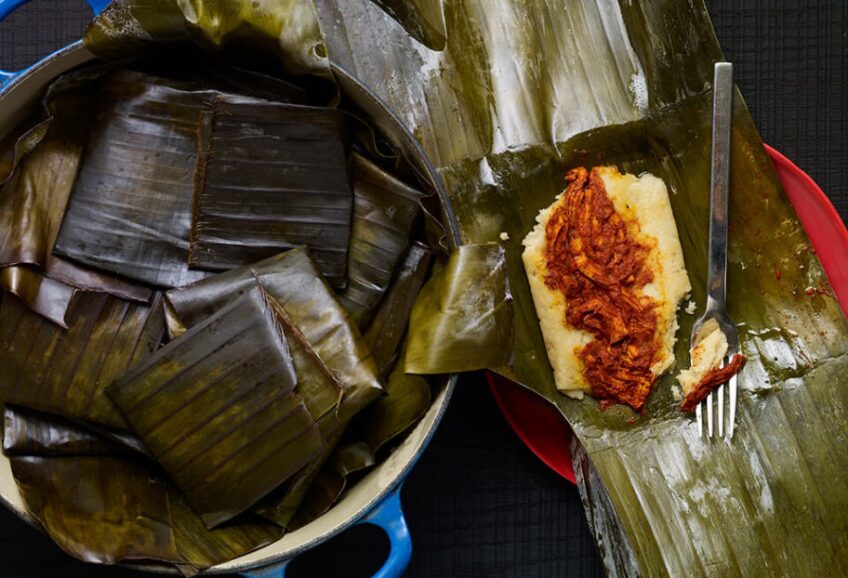Recipe: Mini Pibis

This recipe was originally published on patijinch.com.
Mini Pibis
Tamales Colados de Pollo
14 to 16 tamales
Ingredients
- 3 1/4 cups (about 1 pound) corn masa flour for tortillas or tamales (masa harina)
- 2 3/4 cups chicken broth for masa, plus 1/2 cup for chicken filling
- 1 1/2 teaspoon kosher or coarse sea salt or to taste, divided
- 1 cup lard or vegetable shortening
- 3 tablespoons (or 2 ounces) achiote paste
- 3/4 pound (about 3) ripe Roma tomatoes cut into chunks
- 4 garlic cloves
- 1/4 cup white onion coarsely chopped
- 1 teaspoon dried oregano
- 1/4 teaspoon ground allspice
- 1/4 teaspoon freshly ground black pepper
- 1 tablespoon vegetable oil
- 3 cups cooked shredded chicken
- Banana leaves, fresh or thawed from frozen, cut into 15 pieces, 10-inches in length, plus more for covering the steamer
To Prepare
To make the masa, in a large bowl, combine the masa flour with 2 3/4 cups chicken broth using your hands, kneading the dough until thoroughly mixed and very smooth, not “grainy.”
Put 1 1/2 cups water and 1/2 teaspoon of the salt in a large casserole or pot and set over medium heat. Once it begins to simmer, reduce heat to low and add the masa in batches, working it as you go with the wooden spatula to blend with the water, until it is all incorporated. Add the lard, and work it with the wooden spatula for about 3 to 4 minutes until it is all incorporated and the masa appears “cooked." The masa should smell like cooked corn tortillas and appear to be lightly browning and very thick. Remove from heat.
To make the filling, in a blender, add the remaining 1/2 cup chicken broth, achiote paste, tomatoes, garlic cloves, white onion, oregano, allspice, remaining teaspoon of salt, and black pepper. Puree until completely smooth.
Heat the oil in a pot or casserole over medium heat. Once hot, carefully add the puree (because it will splatter) and cook partially covered for about 10 minutes, stirring frequently, until it thickens and darkens. Add the shredded chicken, stir, and continue to cook for 8 to 10 minutes more, stirring occasionally, until the mixture is very moist but not wet – like a sloppy Joe - and most liquid has been absorbed. Set aside.
Turn a burner on to low heat. Using tongs, slowly pass each banana-leaf piece over the flame on both sides and set aside (so they will be resilient, malleable and not break).
One by one, set each leaf piece on your counter with the shiny, outer side down. Spoon about 1/4 cup of masa into the center and spread to form a rectangle of about 4”x 3”. With the spoon, make a shallow channel down the middle, creating a stripe in the masa. Spoon a couple tablespoons of the seasoned shredded chicken right down the middle. Gently close each tamal by folding the longer sides first and then the sides as if making a flat and tight package, but being careful not to press on the tamal too much.
Prepare your tamalera or steamer: Add just enough water to touch the bottom of steaming basket and a coin (it will jump and make noise to let you know if water runs out). Line the steaming basket with a few banana-leaf pieces to gently cover the base. One by one, add the tamales, stacking them as evenly as you can, staggered in the same position as when you made them: laying them flat, with opening side on the top. Once you are done, cover with a few more pieces of banana leaves.
Set the steamer uncovered over high heat, once there is a bit of steam coming out and the water starts boiling a few minutes later, cover, reduce heat to medium, and cook for 50 minutes to an hour. The leaves will have changed to a much darker color and will have completely wilted to wrap themselves as a second skin over the tamales, and the tamales should feel firm. Turn off the heat.
Let the tamales sit covered for 10 to 15 minutes – so they firm up – or until ready to serve. The tamales can be made ahead of time, and reheated in steamer. They can be refrigerated up to 5 days, or frozen in sealed plastic bags for 6 months, and reheated the same way.


